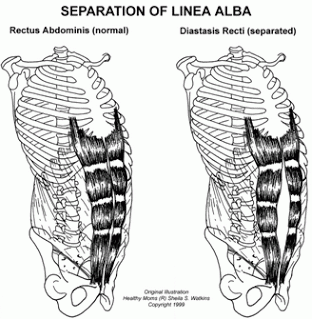Our post partu m patient came in today with several complaints: painful breastfeeding, diastasis recti, and dyspareunia (painful intercourse). After careful evaluation we found her left breast to have 2 areas of clogged ducts, 1.5 fingers width diastasis recti at the umbilicus (belly button), and moderate pain of the pubococcygeus muscles (part of the pelvic floor muscles). The pubococcygeus is the first deep pelvic floor muscle on either side of the vagina. The pubococcygeus muscles are the most stretched and undergo the greatest strain during vaginal delivery as proven via 3-D computer simulated vaginal delivery (Lien KC et al. Obstet Gynecol 2004;103(1):31-40). The pain in the pubococcygeus muscles was causing her pain upon intercourse attempts. Her treatment consisted of manual therapies to the breast, therapeutic ultrasound to the clogged duct areas using an effective protocol, manual therapies to the abdominals including rectus abdominus and obliques, visceral mobilization, and pelvic floor muscle myofascial release/massage. Myofascial trigger points were found in the pubococcygeus muscles yet resolved with specific trigger point release techniques. Re-education of the transverse abdominus and rectus abdominus as well as pelvic floor muscles occurred. Her breast pain fully resolved during the treatment yet there still remained some hardened nodules in the breast which may reveal her having had prior longstanding cysts. Her diastasis recti decreased to 1 finger width. She is to continue with applying moist heat to her breast daily at home and self breast massage was instructed. She was given corrective diastasis recti exercises for home and instructed in pelvic floor muscle exercises to resolve pain and resume painfree intercourse. She’ll return for a follow-up in 4 weeks. #midwife#breastfeeding #postpartum #obstetrics
m patient came in today with several complaints: painful breastfeeding, diastasis recti, and dyspareunia (painful intercourse). After careful evaluation we found her left breast to have 2 areas of clogged ducts, 1.5 fingers width diastasis recti at the umbilicus (belly button), and moderate pain of the pubococcygeus muscles (part of the pelvic floor muscles). The pubococcygeus is the first deep pelvic floor muscle on either side of the vagina. The pubococcygeus muscles are the most stretched and undergo the greatest strain during vaginal delivery as proven via 3-D computer simulated vaginal delivery (Lien KC et al. Obstet Gynecol 2004;103(1):31-40). The pain in the pubococcygeus muscles was causing her pain upon intercourse attempts. Her treatment consisted of manual therapies to the breast, therapeutic ultrasound to the clogged duct areas using an effective protocol, manual therapies to the abdominals including rectus abdominus and obliques, visceral mobilization, and pelvic floor muscle myofascial release/massage. Myofascial trigger points were found in the pubococcygeus muscles yet resolved with specific trigger point release techniques. Re-education of the transverse abdominus and rectus abdominus as well as pelvic floor muscles occurred. Her breast pain fully resolved during the treatment yet there still remained some hardened nodules in the breast which may reveal her having had prior longstanding cysts. Her diastasis recti decreased to 1 finger width. She is to continue with applying moist heat to her breast daily at home and self breast massage was instructed. She was given corrective diastasis recti exercises for home and instructed in pelvic floor muscle exercises to resolve pain and resume painfree intercourse. She’ll return for a follow-up in 4 weeks. #midwife#breastfeeding #postpartum #obstetrics
Post Partum Physical Therapy Performed Head to Toe Today
Posted by webmaster on Aug 3, 2015 in Uncategorized



